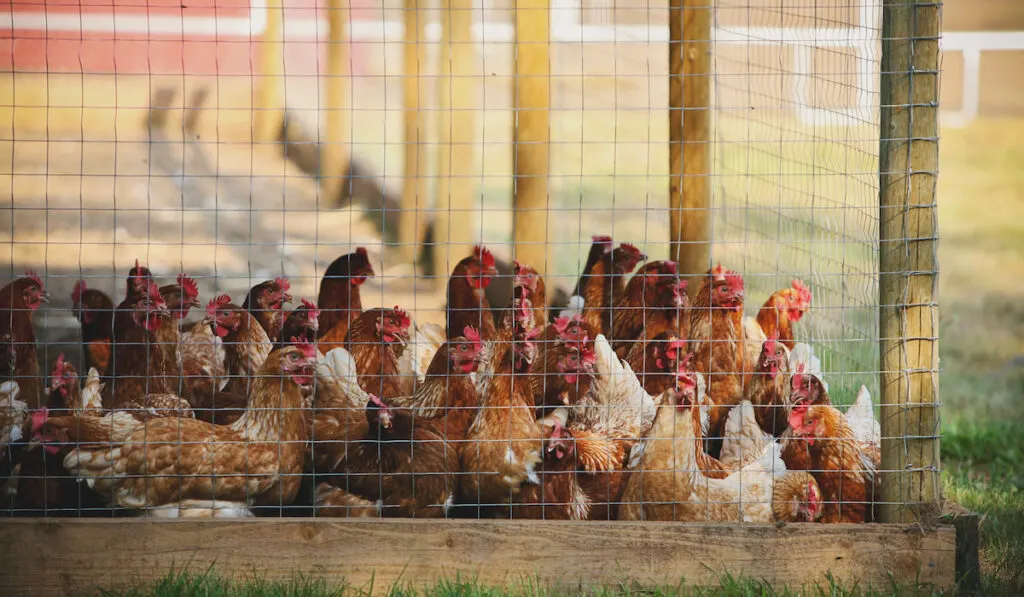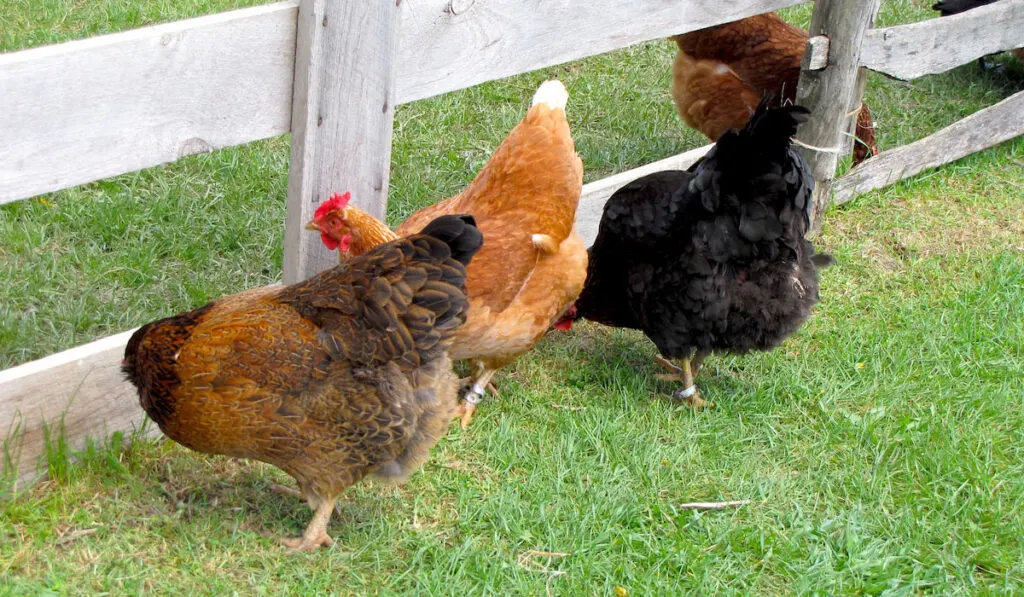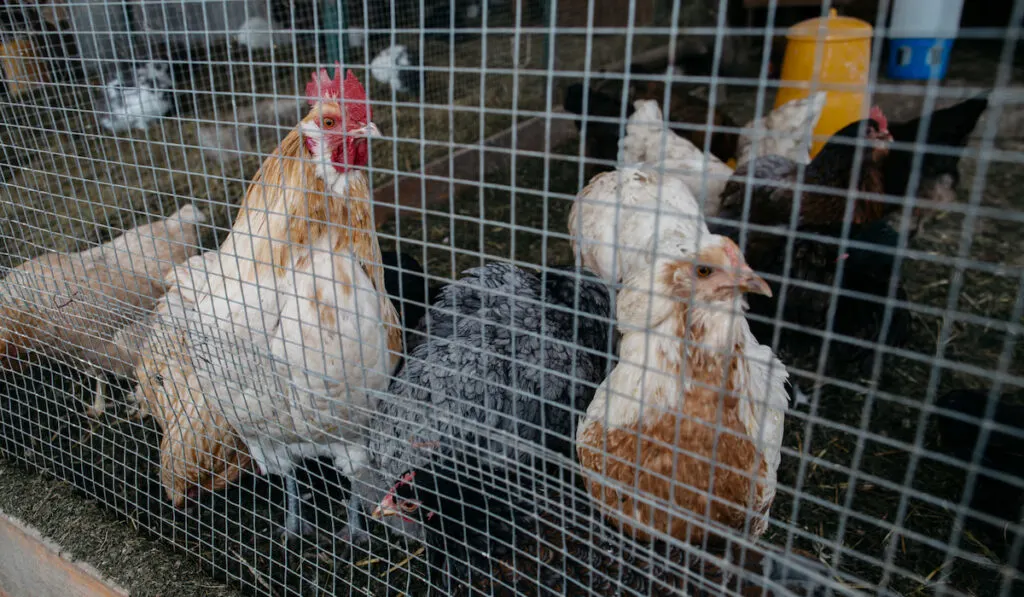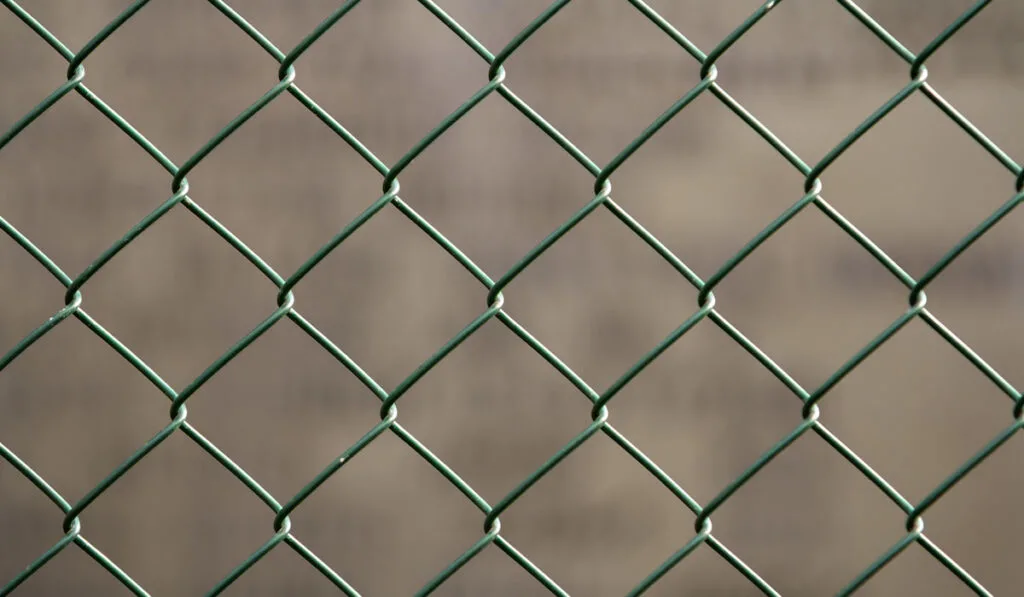Are you thinking of building a chicken pen? You probably already know that you need fencing, but what building materials should you use?
We are going to cover the top materials for building chicken fencing, including:
- Wood and welded wire mesh
- Wood
- Chicken wire
- Electrical netting
- Chain link
Recognizing the different benefits these materials offer will help you work out what to use.
We’ll look at the pros and cons of these materials to ensure you can build a great fenced enclosure for your birds.
Table of Contents
1. Wood and Welded Wire Mesh

This is one of the most common types of fencing you will see for chicken pens. It has a few major advantages:
- Reasonably inexpensive
- Easy to construct
- Sturdy
- Allows you to see into the pen
- Lets plenty of light in
- You can build an overhead structure to protect the chickens from birds of prey
However, a few downsides include:
- Won’t deter all predators
- If you don’t dig it into the ground, creatures will go under it
- You need to use proper mesh, or it will rust and fall apart
- Little protection from the elements
You will need:
- Strong wooden posts (usually 4×4)
- Welded wire mesh (not chicken mesh)
- Attachments, such as screws, nails, etc.
- Tools
These kinds of fences are best dug into the ground so that foxes, rats, and other predators cannot access the pen from beneath. It’s important to use proper welded wire mesh, because chicken wire will rust fairly quickly, and may not be robust enough to protect your chickens.
If possible, you should build this sort of fencing to support an overhead cover as well. This protects your birds from all angles. However, you will need to add a gate so that you can access the pen.
2. Wood

You can just build a full wooden fence around your chickens. This will offer more windproofing and it’s hard for predators to force their way through, but it isn’t perfect.
The advantages include:
- Good weatherproofing
- It’s reasonably easy to build
- It’s sturdy
- It looks attractive
The disadvantages are:
- It can be very expensive to build a full wooden fence
- It blocks light from the pen
- You cannot see your chickens
- An overhead cover may be harder to construct, and will need to be made of mesh to ensure the birds still get enough light
You will need:
- Enough wooden planks to create a large perimeter around your chickens
- Cross-beams to support the planks
- Attachments
- Tools
Wooden fences are vulnerable to predators going under them, so make sure you dig the fence boards into the ground. Bear in mind that the materials can be pricey, and this is quite a lot of work.
These fences also prevent you from being able to watch your chickens, but they are robust and good against casual predators and the elements. If you can afford one, this is a very protective fence.
3. Chicken Wire

Chicken wire is a popular material and again has a few pros and cons. Despite the name, it is probably not your best option for fencing in your chickens, so don’t choose it without doing some careful research first.
The advantages:
- It’s cheap and can be pegged down using thin wooden or metal stakes
- It’s reasonably easy to move
- It lets you see into the pen
- It lets plenty of light in
The disadvantages:
- It will rust and lose its durability quickly
- You cannot build an overhead cover easily
- If you don’t dig it into the ground, predators will go under it
- Rats can bite through it
You will need:
- Enough chicken wire to create a perimeter
- Wooden or metal spikes to drive into the ground
- Staples to attach the wire to the spikes
In general, this sort of fencing is not robust enough to offer chickens much protection. It will work for daytime fencing to keep the birds in, but it’s not suitable against predators and it will quickly degrade.
4. Electrical Netting

A more expensive option, this is usually viable if you have big flocks of chickens to protect. It can be preferable to constantly replacing fencing or losing your flock to predators.
Its advantages include:
- Superb predator deterrent
- You can see into the pen
- It lets lots of light in
- It’s robust
- It’s reasonably easy to build
A few downsides include:
- It tends to be expensive
- It needs a power source and has an ongoing power cost
- Determined creatures might dig under it
- It doesn’t offer weatherproofing
- You can’t easily add overhead cover
You will need:
- Electric netting
- Stakes to attach it to
If you have a big flock and you want to let them roam over a wide area, electric netting is a good way to keep predators away and the birds safe. It doesn’t offer protection from the elements, however, and you will need a reliable power source nearby.
5. Chain Link Fencing

A viable option in some situations, chain link fencing is sturdy and can be used to create a strong barrier around a chicken pen.
Its advantages include:
- It is robust
- It lets you see into the pen
- It is reasonably inexpensive
- It lets plenty of light in
- You can add overhead cover
The downsides are:
- It is not totally predator proof
- It’s hard to dig into the ground
- It isn’t weatherproof
You will need:
- Chain link mesh
- Wooden posts for the corners
- Attachments
- Tools
This kind of fencing is vulnerable to raccoons. These creatures can slip their paws through and grab chickens. They may kill them even if they can’t eat them. Many creatures can also dig underneath.
You can use this fencing if you have low predator concerns, but bear its weaknesses in mind. In many cases, electric netting will be preferable.
Conclusion
There are many different materials that you can use to create chicken fencing. Make sure you choose one that suits your unique situation, the predators that you’re likely to deal with, and gives your birds the best possible life they can enjoy.
